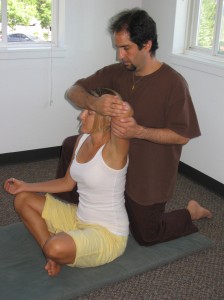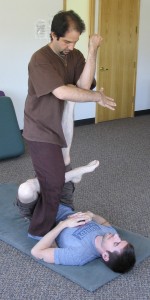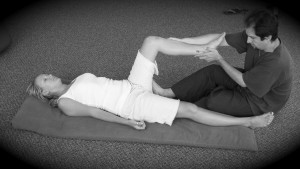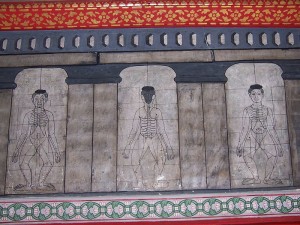Thai Yoga Therapy is a system of reflexology, acupressure, and assisted stretching developed in Thailand, and influenced by the traditional medicine systems of India, China, and Southeast Asia.
This form of bodywork is often performed on the floor, and the client wears comfortable clothes that allow for movement. No oils are used in Thai Yoga Therapy.
In the Thai language it is usually called Nuat Phaen Thai (Thai: นวดแผนไทย; lit. Thai-style bodywork) or Nuat Phaen Boran (Thai: นวดแผนโบราณ, IPA: [nûət pʰɛ̌ːn boːraːn]; lit. ancient-style bodywork), though its formal name is merely Nuat Thai (Thai: นวดไทย, lit. Thai bodywork) according to the Traditional Thai Medical Professions Act, BE 2556 (2013)
 The Thai Yoga Therapy recipient changes into loose, comfortable clothes and lies on a mat or firm mattress on the floor. The receiver may be positioned in a variety of Hatha yoga-like asanas during the course of the work, but deep static and rhythmic pressures form the core of the work. The body will be energized and rejuvenated after the session, or calmed and sedated, depending on the need.
The Thai Yoga Therapy recipient changes into loose, comfortable clothes and lies on a mat or firm mattress on the floor. The receiver may be positioned in a variety of Hatha yoga-like asanas during the course of the work, but deep static and rhythmic pressures form the core of the work. The body will be energized and rejuvenated after the session, or calmed and sedated, depending on the need.
The practitioner leans on the recipient’s body using hands and usually straight forearms locked at the elbow to apply firm rhythmic pressure. The work generally follows the ‘Sen’ lines on the body—somewhat analogous to meridians or channels in Chinese medicine, and nadis in Ayurvedic. Legs and feet of the giver can be used to fixate the body or limbs of the recipient. In other positions, hands fixate the body, while the feet do the massaging action. A full Thai Yoga session typically lasts one hour or more, and includes rhythmic pressing and stretching of the entire body; this may include pulling fingers, toes, ears, walking on the recipient’s back, and manipulating the recipient into many of the traditional Yoga Asanas. There is a standard procedure and rhythm to the work, which the practitioner will adjust to fit each individual client.
 The true practice of the art of healing in traditional Nuad Boran (Thai Yoga Therapy) is the compassionate intent of the healer. The Buddhist spiritual practices associated with Thai Yoga Therapy cultivate humility, awareness, and concentration in the healer designed to bring the practitioner to a deeper level of awareness of herself and the client. This compassionate state of being is termed “metta”, which usually translates as “loving kindness”.
The true practice of the art of healing in traditional Nuad Boran (Thai Yoga Therapy) is the compassionate intent of the healer. The Buddhist spiritual practices associated with Thai Yoga Therapy cultivate humility, awareness, and concentration in the healer designed to bring the practitioner to a deeper level of awareness of herself and the client. This compassionate state of being is termed “metta”, which usually translates as “loving kindness”.
The founder of Thai Yoga Therapy is said to have been Shivago Komarpaj (ชีวกโกมารภัจจ์ Jīvaka Kumarabhacca), who is said in the Pāli Buddhist Canon to have been the Buddha’s physician over 2,500 years ago. In fact, the history of Thai Yoga Therapy is more complex than this legend of a single founder would suggest.
Generally speaking, practitioners of modern Thai Yoga Therapy operate on the theory that the body is permeated with “lom,” or “air,” which is inhaled into the lungs and which subsequently travels throughout the body along 72,000 pathways called “sen,” or “vessels.” Typically, therapists manipulate a handful of major sen lines by pressing certain points along the lines. In most models, the sen originate at the navel and spread throughout the body to terminate at the orifices. A significant part of the practice of Thai Yoga Therapy also includes yoga-like stretches which are intended to stimulate the sen and move lom through the body via a pumping action which is connected with the patient’s breathing.
 The theory of sen and lom is often translated into English as “meridians” and “energy.” While there are some superficial similarities to Chinese meridian theory, the Thai system is in fact more closely related to the nadir of the Indian traditions of yoga and Ayurveda. It is said in the Thai tradition that there are 72,000 sen lines. This should not, however, be taken literally, as this number is a traditional Buddhist way of indicating an infinite amount — the point being that each cell in the human body is linked to every other cell through this infinite and intricate mesh of energy. This energy is known as prana (Sanskrit), Qi (Chinese) or palang sak (Thai). The pranic networks permeate the body of any living being, and vibrate in response to physiological, psychological, and spiritual experiences. No one can name or diagram all of the body’s infinite energy circuits. However, 10 main sen are commonly taught and used in Thailand’s bodywork schools to treat the entire body.
The theory of sen and lom is often translated into English as “meridians” and “energy.” While there are some superficial similarities to Chinese meridian theory, the Thai system is in fact more closely related to the nadir of the Indian traditions of yoga and Ayurveda. It is said in the Thai tradition that there are 72,000 sen lines. This should not, however, be taken literally, as this number is a traditional Buddhist way of indicating an infinite amount — the point being that each cell in the human body is linked to every other cell through this infinite and intricate mesh of energy. This energy is known as prana (Sanskrit), Qi (Chinese) or palang sak (Thai). The pranic networks permeate the body of any living being, and vibrate in response to physiological, psychological, and spiritual experiences. No one can name or diagram all of the body’s infinite energy circuits. However, 10 main sen are commonly taught and used in Thailand’s bodywork schools to treat the entire body.
How to prepare for a Thai Yoga session? Please wear loose, comfortable cotton clothing, such as a t-shirt, sweats, or shorts. Ideally, nothing is worn under, but let me know if you would prefer to. Please do not have on any make-up on, and no jewelry. It is best not to have this work done on a full stomach.
A session lasts approximately 60 minutes, including some post-session minor acupuncture, if desired.
Laith Naayem L.Ac., MSOM
Licensed Acupuncturist
New Windsor, NY
(845) 674-7639

